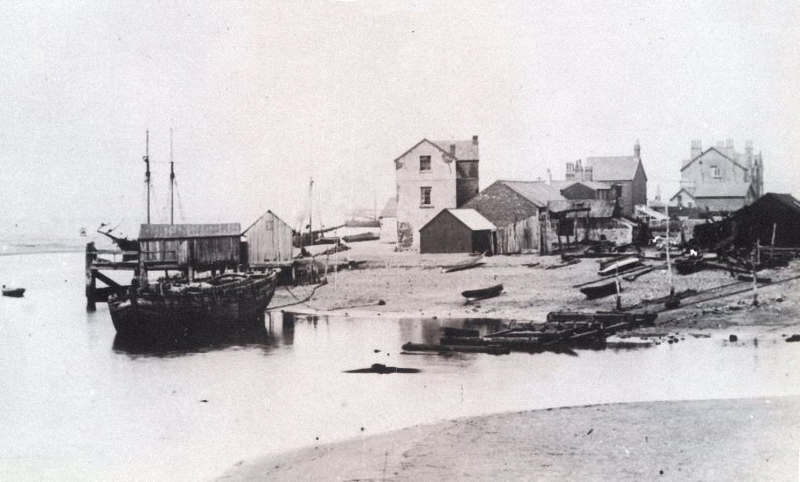The Policeman’s Wife
When P. C. Maurice Jones, Meliden’s first resident policemen died at age of 37 in March 1874, his wife, Deborah Jones [née Davies] was living at 1, Swan Terrace, next to the Swan Inn, almost opposite Mount Pleasant. She had lost four children in infancy and had to find some way of getting by with her one surviving child at a time before police widows’ pensions. Fortunately, she came from a good Abergele family, the daughter of a headmaster and had relatives in the drapery and tailoring trades. She herself had trained as a milliner before her marriage to Maurice Jones at the Welsh Church in Liverpool. [St. David’s was demolished in 1911 in order to extend the Adelphi Hotel.]
She left Meliden and went to live in the part of Rhyl known as New Town which was on the Morrisons’ side of the railway, where a building boom was in progress—all the rows of Victorian houses we can see now came into existence around that time. She worked as a milliner and it was quite proper that she should resume her old trade and support herself. She lived on Sisson Street, a very decent area, as a boarder in the home of Peter Parry, a draper from Abergele and whose wife was probably a relative.
Now the Dickensian part of her story begins—by 1891, the census shows that she was living in the shanty-town that had grown up around the Foryd harbour. What had happened? At first I did not think it was the same Deborah Jones but as my dossier built up it became certain. The 1891 census does not record her occupation—which is very odd. In those days, before old age pensions were introduced, most widows without an income did laundry, dressmaking or entered domestic service to make ends meet—but she may have been in receipt of a police widow’s pension which had just started the previous year. I was suspicious and searched.
Tucked in at the bottom of a column a few years earlier in the Rhyl Advertiser, August 28, 1882:
DRUNKENNESS—Deborah Jones, Vale Road, charged by P.C. Griffiths with being drunk and disorderly, was sent to gaol for seven days.
The seven day sentence suggests that it was not her first offence. She was in court again in April 1886 when she was caught drinking at the Victoria Inn on a Sunday morning—in the company of thirteen men! In October 1889 she was fined 5s and 6s costs for misconducting herself on Kinmel Street—unable to pay, she was sent to gaol again for seven days.
March 15,1890 the Rhyl Journal reported:
AN AGED TIPPLER DEFIES THE SUNDAY CLOSING ACT
A miserably poor looking creature named Deborah Jones was brought up in custody charged with being drunk and incapable in Wellington Road on Sunday.—The case was proved by P.C. Taaffe.—The defendant admitted that she bad had two or three glasses, but she was not incapable except to resist the rough lads who pushed her down. However if the Bench would only have patience with her she would not touch another drop. She had work to go to, to a woman who was very bad in bed. She ought to have been with her yesterday.
The magistrates did not comply with the poor woman’s supplication for mercy but sent her to prison for seven days in default of paying a fine of 5s. and costs.
An aged tippler? She was only 57. After living at various addresses on Vale Road in the 1880s, she had moved to share a room with another widow in the rundown Foryd hovel before becoming a boarder at James Foley’s Common Lodging House, Millbank—near the site now occupied by Matalan, off Vale Road. The house was well known to the police, who were called there very frequently to deal with drunk and disorderly lodgers. Foley was himself a petty criminal and street trader with a series of trading convictions and prosecutions for drunkenness. Maurice Jones would have been turning in his grave.
In 1902 came her last court appearance. Rhyl Journal, October 18, 1902:
DISCHARGED WITH A CAUTION
P.C. Lloyd summoned Deborah Jones, charwoman, Foley’s Lodging-house, Millbank, for being drunk and disorderly in Brighton Road on the 4th inst. Defendant pleaded not guilty, but the Bench found otherwise, and taking into consideration her circumstances, discharged her with a caution, at the same time advising her to go to the Workhouse.
The bench must have known her pitiful life story and in consideration of her being almost 75 years of age, penniless and in poor health, could not bring it upon themselves to send her to gaol. She made the only possible choice and entered the workhouse. Nine years later the burial records at St. Melyd’s Church contain the final entry: Deborah Jones, Burial No.24; Abode, Union Workhouse St. Asaph; When buried, May 13th 1911; Age 83.
Her husband’s and children’s graves are at the bottom of the old churchyard. The path to the new graveyard passes over their two graves on the final bend. Could she be buried with them? The inscriptions reads:
In Memory of Two Children of Maurice Jones P.C. Of Meliden by Deborah his Wife. Sus.ah April 27 1863 aged 2½ Yrs. Thos. Died Dec 13 1864 aged 3 Yrs. Also the above named [The inscription giving the date of Maurice Jones’s death seems to be below ground—is his wife’s name there?]
In Memory of an infant of M.D. Jones P.C. Died Dec. 22nd 1865. [aged 4 days] Abel Jones died Dec the 12th 1870 Aged 4 Yrs.

In the 1890s, the Foryd was a very disreputable shanty town.
